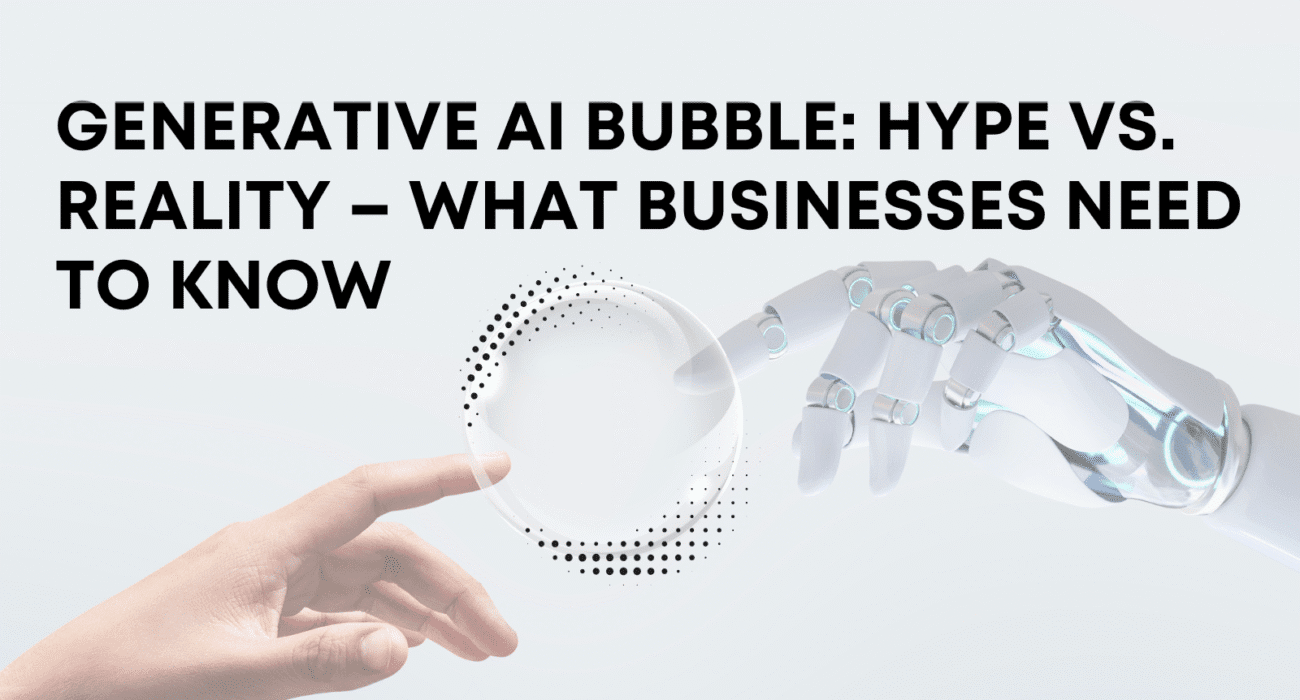Introduction
Generative AI has become one of the most talked-about technologies in recent years. From tools like ChatGPT and MidJourney to enterprise-level AI applications, businesses across industries are exploring how artificial intelligence can transform operations, marketing, customer experience, and innovation. For businesses looking to adopt AI-powered digital solutions, Japnaaz Software offers tailored web and software development services. However, along with this excitement comes a critical question: Are we experiencing a generative AI bubble that could eventually burst, or is this the beginning of a long-term revolution?
In this article, we’ll explore the hype vs. reality behind generative AI, its risks and opportunities, and what businesses need to know to make smart, future-ready decisions.
What Is Generative AI?
Generative AI refers to artificial intelligence systems that can generate new content, such as text, images, video, audio, or code, based on training data. Unlike traditional AI, which focuses on analyzing or classifying data, generative AI can create outputs that mimic human creativity.
Popular examples include:
- ChatGPT for text-based communication.
- DALL·E and MidJourney for AI-generated art.
- Synthesia for AI-powered video creation.
- GitHub Copilot for AI-assisted coding.
This disruptive technology is reshaping industries, but the hype around it also raises concerns about sustainability.
The Hype Around Generative AI
The buzz surrounding generative AI is driven by several key factors:
- Explosive Adoption Rates
Generative AI tools have grown faster than many previous technologies. ChatGPT, for example, reached 100 million users in just two months, making it the fastest-growing consumer app in history. - Investor Confidence
Tech giants like Microsoft, Google, Meta, and OpenAI have invested billions into generative AI research, signaling strong confidence in its future potential. - Business Use Cases Across Sectors
From marketing automation and customer service chatbots to drug discovery and legal document drafting, businesses are experimenting with generative AI to cut costs and improve efficiency. - Media Hype & Public Fascination
Generative AI dominates headlines, creating a fear of missing out (FOMO) among businesses that don’t want to be left behind.
The Reality: Are We in a Bubble?
While the hype is undeniable, experts caution that we might be in an AI bubble, similar to the dot-com bubble of the late 1990s. Let’s break down the reality.
1. Overvaluation of AI Startups
Many AI startups are being valued at billions of dollars despite unproven revenue models. If expectations don’t align with actual performance, valuations may collapse.
2. High Operational Costs
Generative AI models require massive computing power and energy consumption, making them expensive to maintain and scale. Businesses that adopt AI without a clear ROI strategy may face challenges.
3. Ethical & Legal Challenges
Generative AI raises issues like:
- Copyright infringement (AI using copyrighted works to generate content).
- Bias and discrimination in outputs.
- Data privacy concerns for businesses handling sensitive information.
4. Limited Accuracy & Reliability
AI-generated content is often impressive but not always accurate. Businesses relying solely on AI without human oversight risk misinformation and reputational damage.
Lessons from Past Tech Bubbles
To understand whether generative AI is a bubble, we can look at past tech booms:
- Dot-com Bubble (1995–2000): Many internet companies collapsed, but survivors like Amazon and Google shaped the future of the web.
- Blockchain & Crypto Hype (2016–2021): While some projects failed, blockchain remains a core innovation with real-world applications.
Even if parts of the generative AI market collapse, the technology itself is here to stay and will evolve into sustainable use cases.
Real-World Business Applications of Generative AI
Despite risks, generative AI is already delivering measurable value across industries:
- Marketing & Advertising
- Personalized ad copy and visuals.
- Automated social media content creation.
- Customer behaviour analysis for better targeting.
2. Healthcare
- AI-assisted drug discovery.
- Medical image analysis.
- Patient engagement via AI chatbots.
3. Finance
- Fraud detection and prevention.
- Automated financial reporting.
- Customer service AI assistants.
4. E-commerce & Retail
- AI product descriptions.
- Virtual try-on for fashion.
- Intelligent recommendation engines.
5. Software Development
- AI-assisted coding through tools like GitHub Copilot.
- Faster bug detection and resolution.
How Businesses Can Navigate the Generative AI Bubble
Instead of blindly following hype, businesses need to take a strategic approach to AI adoption. Here are some tips:
1. Focus on ROI-Driven Use Cases
Identify where AI can reduce costs, improve efficiency, or enhance customer experience. Avoid implementing AI just for the sake of being trendy.
2. Maintain Human Oversight
Generative AI should augment, not replace, human talent. A balance of automation and human creativity ensures accuracy and accountability.
3. Invest in Data Security
Since generative AI relies heavily on data, businesses must prioritize cybersecurity and data governance to build customer trust.
4. Train Employees for AI Collaboration
Upskilling employees to work with AI tools ensures smoother adoption and maximizes business value.
5. Prepare for Regulation
Governments worldwide are drafting AI regulations to address bias, copyright, and safety concerns. Staying compliant is critical for sustainable growth.
The Future of Generative AI
While some companies may over promise and fail, generative AI is not going away. Analysts predict that by 2030, AI could add $15.7 trillion to the global economy (PwC report).
The future will likely bring:
- Smarter AI models with higher accuracy.
- Lower costs of adoption as infrastructure improves.
- Ethical frameworks to ensure responsible use.
- Industry-specific AI solutions tailored to business needs.
Conclusion
The generative AI bubble may be real in terms of hype and inflated valuations, but the underlying technology is transformative. Businesses that adopt AI wisely—focusing on ROI, ethics, and long-term sustainability—will emerge as leaders in their industries.
Businesses that adopt AI wisely—focusing on ROI, ethics, and long-term sustainability—will emerge as leaders in their industries. To learn more about digital transformation and AI integration, visit Japnaaz Software.”
Instead of asking “Will the AI bubble burst?”, the better question is: How can businesses harness AI responsibly to stay competitive in a rapidly changing digital world?

